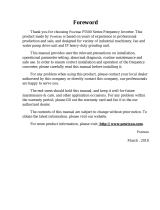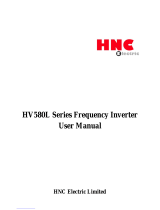Guide . . . . . . . . . . . . . . . . . . . . . . . . . . . . . . . . . . . . . . . . . . . . . . . . . . . . . . . . . . . . . . . . . . . .
Introduction . . . . . . . . . . . . . . . . . . . . . . . . . . . . . . . . . . . . . . . . . . . . . . . . . . . . . . . . . pag. 6
i.1 Preface . . . . . . . . . . . . . . . . . . . . . . . . . . . . . . . . . . . . . . . . . . . . . . . . . . . . . . . . . pag. 6
i.2 Precautions . . . . . . . . . . . . . . . . . . . . . . . . . . . . . . . . . . . . . . . . . . . . . . . . . . . . . pag. 6
i.3 Products Inspection . . . . . . . . . . . . . . . . . . . . . . . . . . . . . . . . . . . . . . . . . . . . . . . pag. 6
Chapter 1 Safety Precautions . . . . . . . . . . . . . . . . . . . . . . . . . . . . . . . . . . . . . . . . . . pag. 7
1.1 Before Power ON . . . . . . . . . . . . . . . . . . . . . . . . . . . . . . . . . . . . . . . . . . . . . . pag. 7
1.2 During Power ON . . . . . . . . . . . . . . . . . . . . . . . . . . . . . . . . . . . . . . . . . . . . . . pag. 7
1.3 Before Operation . . . . . . . . . . . . . . . . . . . . . . . . . . . . . . . . . . . . . . . . . . . . . . pag. 8
1.4 During Operation . . . . . . . . . . . . . . . . . . . . . . . . . . . . . . . . . . . . . . . . . . . . . . pag. 8
1.5 During Maintenance . . . . . . . . . . . . . . . . . . . . . . . . . . . . . . . . . . . . . . . . . . . . pag. 9
Chapter 2 Model Description . . . . . . . . . . . . . . . . . . . . . . . . . . . . . . . . . . . . . . . . . . pag. 10
2.1 Label description . . . . . . . . . . . . . . . . . . . . . . . . . . . . . . . . . . . . . . . . . . . . . pag. 10
2.2 Ordering Key . . . . . . . . . . . . . . . . . . . . . . . . . . . . . . . . . . . . . . . . . . . . . . . . .pag. 10
2.3 Type selection . . . . . . . . . . . . . . . . . . . . . . . . . . . . . . . . . . . . . . . . . . . . . . . .pag. 11
Chapter 3 Ambient Environment and Installation . . . . . . . . . . . . . . . . . . . . . . . . . pag. 12
3.1 Environment . . . . . . . . . . . . . . . . . . . . . . . . . . . . . . . . . . . . . . . . . . . . . . . . . . . pag. 12
3.2 Environmental Precautions . . . . . . . . . . . . . . . . . . . . . . . . . . . . . . . . . . . . . . . . pag. 13
3.3 Wiring Role . . . . . . . . . . . . . . . . . . . . . . . . . . . . . . . . . . . . . . . . . . . . . . . . . . . . pag. 14
3.3.1 Notice for Wiring . . . . . . . . . . . . . . . . . . . . . . . . . . . . . . . . . . . . . . . . . . . . pag. 14
3.3.2 Fuse Type . . . . . . . . . . . . . . . . . . . . . . . . . . . . . . . . . . . . . . . . . . . . . . . . . pag. 15
3.3.3 Applicable specification of magnetic contactor and wires . . . . . . . . . . . . pag. 16
3.3.4 Precautions for peripheral applications . . . . . . . . . . . . . . . . . . . . . . . . . . pag. 17
3.4 Specifications . . . . . . . . . . . . . . . . . . . . . . . . . . . . . . . . . . . . . . . . . . . . . . . . . . pag. 20
3.4.1 Products Individual Specifications . . . . . . . . . . . . . . . . . . . . . . . . . . . . . . pag. 20
3.4.2 General Specifications . . . . . . . . . . . . . . . . . . . . . . . . . . . . . . . . . . . . . . . pag. 21
3.5 Wiring Diagram RVCF Series Inverter . . . . . . . . . . . . . . . . . . . . . . . . . . . . . . . pag. 23
3.6 Description of inverter terminals . . . . . . . . . . . . . . . . . . . . . . . . . . . . . . . . . . . pag. 25
3.7 Outline Dimensions . . . . . . . . . . . . . . . . . . . . . . . . . . . . . . . . . . . . . . . . . . . . . . pag. 26
Chapter 4 Software Index . . . . . . . . . . . . . . . . . . . . . . . . . . . . . . . . . . . . . . . . . . . . .pag. 29
4.1 Keypad Description . . . . . . . . . . . . . . . . . . . . . . . . . . . . . . . . . . . . . . . . . . . . . pag. 29
4.1.1 Keypad Display and Operation Instruction . . . . . . . . . . . . . . . . . . . . . . . . . . pag. 29
4.1.2 Operation Instruction of the Keypad . . . . . . . . . . . . . . . . . . . . . . . . . . . . . pag. 30
4.1.3 Operation Instruction of the LED Keypad . . . . . . . . . . . . . . . . . . . . . . . . . pag. 31
4.1.4 Operation Instruction of the LCD Keypad . . . . . . . . . . . . . . . . . . . . . . . . . pag. 32
4.1.5 Keypad Operating Example . . . . . . . . . . . . . . . . . . . . . . . . . . . . . . . . . . . pag. 33
4.2 Control Mode Selection . . . . . . . . . . . . . . . . . . . . . . . . . . . . . . . . . . . . . . . . . . .pag. 35
4.3 RVCF Programmable Functions List . . . . . . . . . . . . . . . . . . . . . . . . . . . . . . . .
pag. 36
4.4 Parameter Function Description . . . . . . . . . . . . . . . . . . . . . . . . . . . . . . . . . . . .
pag. 49
CONTENTS
RVCF Advanced User Manual
4 Specifications are subject to change without notice. Pictures are just an example. For special features and/or customization, please ask to our sales network.
310311























